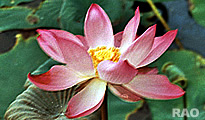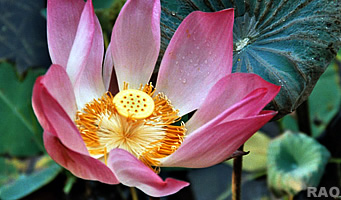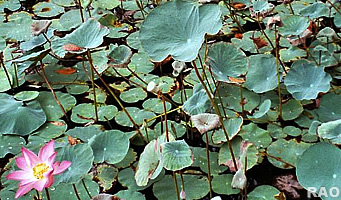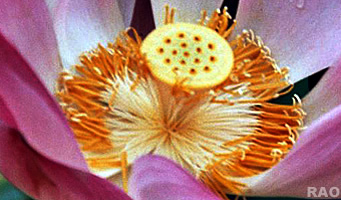 |
| Nepal's Culture |
|
 |
| Lotus Flower |
| The Importance of the Lotus Flower in Buddhism |
 |
|
The lotus flower stands apart in its enormous value to both Hinduism and Buddhism.
The palhi Buddhavamsa shows the existence of four past Buddhas explaining the Buddha Dipamkara to be the first one.
However Mahayana Buddhism reveals the number of past Buddhas to be more than in other Buddhist traditions.
Once Dipamkara Buddha was visiting the city of Dipavati. A Brahmin learned in Vedic lore wanted to honour him and left to see Dipamkara Buddha in festive mood. He happened to see a lady on his way with seven lotus flowers. The flowers, which looked very precious attracted the Brahmin. He proposed the lady that the bunch of lotus flowers be given to him in exchange for five hundred gold coins. He wanted to honour Buddha with these flowers. The lady initially disagreed but then was willing to give only five on the condition that she be his consort until he attained enlightenment.
 |
|
The Buddha Dipamkara as Siddartha Gautama, renowned later as Shakyamuni Buddha was the son of King Suddhodhan and Mayabati and was born in the present garden of Lumbini in west Nepal.
The Buddhist books say Siddartha Gautama did not immediately step on land after his birth. There were seven lotus flowers in front of him when he eventually took his first steps.
The importance of the lotus flower is associated with the origin of the Kathmandu valley also, which was once a big lake. Vipashvi, one of the human Buddhas came to the Kathmandu valley from Bandhumati (India) for meditation in the northern hill of the lake named today as Nagarjun. While he was in deep meditation, he was divinely inspired to sow the lotus flower seed in the lake from his meditating hill. He carried out the divine order in the full moon day of March-April. After six months, a lotus flower bloomed and a light from the divine was inserted into it again on another full moon night. The Adi Buddha in the form of flame was self-created which is Swayambhu today.
 |
 |
After the mahaparinirvana of Shakyamuni Buddha, his teachings were maintained and transmitted among the devotees orally. After about three centuries, the devotees and the monks decided to document them so that it benefit future generations.
There were many meetings among the monks and the devotees to collect all the widely scattered teachings of the Shakyamuni Buddha. But the monks came up with different interpretations over the teachings of Buddha.
The monks who interpreted the teaching of Buddha in a narrow way were addressed as 'Hinayanists', which could be roughly compared with Catholics of the reformation period in medieval Europe. But the monks who accepted and interpreted the teachings generously were addressed as 'Mahayanist', which could again be compared with the Protestants of the same period in Europe.
Both schools of thoughts in Buddhism believe that until salvation is achieved a person undergoes rebirth again and again.
The followers of Hinayana believe that as Shakyamuni Buddha has already achieved enlightenment there would be no possibility for him to be born again. So Hinayanists are of the opinion that he would not come to earth simply to help us to achieve salvation. We have to find enlightenment ourselves.
But the followers of the Mahayana school think differently.
They too agree that a God like Siddartha cannot have a birth like those of other living beings. But this school believes that the God would come many times to help living beings gain salvation. This school believes he would come from the Lotus flower.
This belief of the Mahayana school that Shakyamuni Buddha would come again from the lotus has enhanced the importance of this flower. This is how the lotus flower has been the symbol of generosity in Buddhism. The Hinayana and other younger schools of Buddhism, however, accept the lotus as a holy flower for other reasons.
The Boudhanath Stupa is a wish fulfilling chorten for Tibetans. According to the Tibetan Buddhist legend , the four sons of a poultry keeper lady completed the construction of the Boudhanath temple after the death of their mother.
According to his wish, the first son was made the King of Tibet as he expected he would have more opportunity to spread Buddhism in a virgin land like Tibet. He was King Trisong Datsen, of the eighth century. He invited Santaraksita, a sage of Buddhism, to come to Tibet from India and popularize Buddhism. Upon his arrival in Tibet, many natural calamities occurred and people interpreted it as an unwelcome sign. But Santaraksita recommended the King to invite Padmasambhava who also had tantric powers and would be able to control the devil and spirits coming from the Bon religion to oppose the intrusion of a new religion like Buddhism.
The Tantric Guru Padmasambhava came to Tibet and controlled the menace of the elements and worked a lot to establish the new Buddhist religion in Tibet. The revered Guru, Padmasambhava sits upon the lotus flower itself. The word "Padma" in Sanskrit is lotus flower and he is said to have been born from it and so is called Padmasambhava.
The New York Journal of Medicine reported that Cordyceps has properties similar to Ginseng, being used to strengthen the body after exhaustion or long term illness. It has traditionally been used for impotence, backache, to increase sperm production and to increase blood production. In China, Cordyceps is used medically to regulate and support the gonads and as a lung and kidney tonic. It is used specifically for excess tiredness, chronic cough and asthma, impotence, debility, anemia, to build the bone marrow and reduce excess phlegm.
 |
|
|
|
|